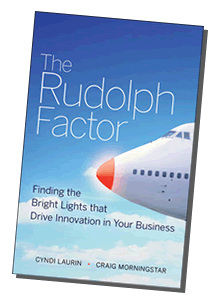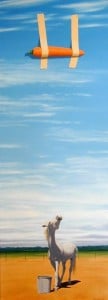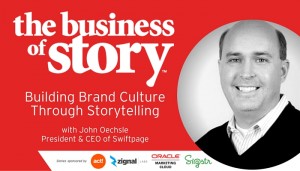This economy certainly has companies looking inward. Just to survive, let alone be sustainable, means questioning every practice and how you do business. We have built our agency primarily on outward bound advertising campaigns that we call marketing movements.
Now Park&Co is being tapped to help organizations with their intenal communications programs. They’re not looking for your typical H.R. storyline. Clients are asking for as much creativity and disruption with their internal campaigns as you will find with award-winning ad campaigns.
These employee-centric campaigns have me digging into a whole new realm of business and motivational books to help us find ways to create messages that are relevant and compelling to the individual worker.

Derrick Mains of Green Nurture recommended, The Rudolph Factor, Finding the Bright Lights that Drive Inoovation in Your Business. The book is a case study about the remarkable turn-around Boeing mastered by applying the leadership principles of the Rudolph Factor to their C-17 plant in Long Beach, California.
What we have found is that human nature tends to promote the vision of the machine without demonstrating why it matters to the goals and dreams of the individual employee. The overiding premise of the Rudolph Factor is.
“Leadership, in its most rudimentary form, is all about, and only about, connecting people to their future.”
One of the surest ways to drive innovation and promote employee buy-in is to marshall the forces of your internal “Rudolphs.” Rudolphs make-up about 10 percent of every organization. They’re just as likely to be on your shipping dock, in engineering, or found in a bright secretary, as they are in the C-suite. Tapping their innate inovative ways is essential to building a sustainable organization.
So what do the look like? According to the Rudolph Factor:
- Rudolphs are naturally creative, and often appear eccentric to the their co-workers
- They solve problems in unconventional ways and love to get their hands dirty
- Rudolphs spend an average of four to six hours per day outside of work thinking about ways to better the organization
- They are extraordinarily passionate about their work
- They often ask, “Why?” even when it makes others around them uncomfortable
- They question the status quo and challenge their colleagues to think outside the box
- Rudolphs see possibility, opportunity and potential, usually creating nontraditional or unconventional opportunities
- Although they enjoy it, Rudolphs are not motivated by self promotion
- They are adept at connecting the dots that others do not see to solve problems and make improvements
- They are systems thinkers seeing the whole forest rather than a single tree
- Although they think like an entrepreneur, they do not want to run their own businesses
- Rudolphs prefer collaboration
- They have the ability and confidence to turn their ideas into action
- They often act on an idea before they know how it can be done (My father always told us, “Do something, even if it’s wrong.”)
- Rudolphs do not rely on convention to get things done, and they often appear as trailblazers, troublemakers, or loose cannons to non-Rudolphs
If you find yourself redefining how your company or organization can fly through the fog of the recession and become more sustainable, I highly recommend “The Rudolph Factor.” What book would you recommend to add to my library on internal communications and motivation?











at 10:39 am
[…] Park’s blog post, “The 15 characteristics of Rudolphs and how they can help steer your company thru the fog of the recession” addresses one of our favorite books, The Rudolph Factor by Cindy Laurin who was a guest on our radio show. […]
at 4:22 pm
[…] the lens of ‘Rudolph Thinking’ to look inward for managing business tough times. Park’s blog post, “The 15 characteristics of Rudolphs and how they can help steer your company thru the fog […]
at 6:56 am
[…] Jay Baer and Amber Naslund. The Now Revolution is an amalgam of the bottom-up management found in The Rudolph Factor, Zappo’s ubber-company-culture tome, Delivering Happiness, and Chris Brogan’s Trust […]